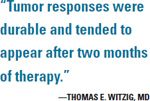Everolimus achieves ‘potent’ results in rare form of NHL
There currently are no approved therapies for Waldenström macroglobulinemia, but everolimus (Afinitor) may be the answer. A collaborative phase II study showed encouraging single-agent activity with everolimus in relapsed and/or refractory disease.
There currently are no approved therapies for Waldenström macroglobulinemia, but everolimus (Afinitor) may be the answer. A collaborative phase II study showed encouraging single-agent activity with everolimus in relapsed and/or refractory disease.
"Everolimus represents one of the more potent therapeutic agents in relapsed Waldenström macroglobulinemia. Tumor responses were durable and tended to appear after two months of therapy," said senior author Thomas E. Witzig, MD, professor of medicine at the Mayo Clinic in Rochester, Minn.
Everolimus, an mTOR signal transduction pathway inhibitor, is currently approved by the FDA for treatment of advanced kidney cancer in patients for whom first-line sunitinib (Sutent) or sorafenib (Nexavar) has failed and is investigational in several other cancers. Targeting the mTOR pathway is thought to control cell proliferation and survival.
The study by Dr. Witzig and colleagues included 50 evaluable patients (median age of 63 years) with measurable disease that was relapsed or refractory after the patients had received previous therapies. These therapies included rituximab (Rituxan) (administered to 96%), alkylators (64%), purine analogs (32%), and other regimens (40%). According to the international scoring system for Waldenström macroglobulinemia, 50% of the study population was at intermediate or high risk for the disease.

Single-agent everolimus was initiated at an oral dose of 10 mg/d in the fasting state, and the dose was adjusted or delayed according to adverse effects. Four weeks of treatment was considered one cycle. Patients were treated until unacceptable toxicity or disease progression occurred, Dr. Witzig said.
According to the results, single-agent oral everolimus administered daily achieved an overall response rate of 70%; the partial response rate was 42%, and the minimal response rate was 28%.
An additional 16% of patients (eight of 50) had stable disease over the course of the study. These response rates compare favorably with phase II trials of other single agents in this setting, including bortezomib (Velcade), the authors stated (J Clin Oncol 10:1408-1414, 2010).
In 62% of patients, the disease remained progression-free at the end of 12 months. Median duration of response and median progression-free survival have not yet been reached. However, in studies of other single agents in this setting, such as bortezomib and rituximab, the median duration of response has been approximately 12 months or less.
Moreover, toxicities were manageable and the adverse-event profile of everolimus appears to be an improvement over that of fludarabine and alkylating agents, especially in older adults.
Dose reductions because of toxicity were made in 52% of patients, most commonly for hematologic toxicities with cytopenias. Dr. Witzig pointed out that patients with grade 1 thrombocytopenia could enroll in this trial and were allowed to continue full-dose therapy if they had an acceptable platelet count.
"There is no doubt that everolimus can produce thrombocytopenia. However, the rate of grade 3 and 4 thrombocytopenia observed [in this trial] is partially due to the relapsed state of these patients and the fact that they could enter the study with a platelet count of 75,000," Dr. Witzig said.
Grade 3 or higher toxicities were found in 56% of patients. Grade 3 pulmonary toxicities, which developed in three patients (6%), were manageable.
On the basis of this preliminary study, Dr. Witzig recommended initiating everolimus therapy in patients with Waldenström macroglobulinemia using 10 mg/d, with dose reductions to 5 mg/d or 5 mg every other day, or initiating everolimus at the 5-mg daily dose, increasing to 10 mg/d as tolerated.
Additional phase II and III studies are being carried out with everolimus in various forms of lymphoma, including diffuse large B-cell lymphoma and relapsed and/or refractory mantle cell lymphoma.
VANTAGE POINT Everolimus shows impressive single-agent activity
Shuo Ma, MD, PhD
These are exciting study results "demonstrating that everolimus appears to be a very promising new agent with impressive single-agent activity in Waldenström macroglobulinemia and acceptable toxicity," said Dr. Ma, an assistant professor of medicine at Northwestern University in Chicago and a member of the Robert H. Lurie Comprehensive Cancer Center.
Everolimus blocks the tumor's key survival and proliferation pathways, Dr. Ma explained, making it likely that this novel agent will enhance the cytotoxic effects of other anti-tumor agents. She agreed with Dr. Witzig and colleagues that everolimus should be studied further for the treatment of Waldenström macroglobulinemia in combination with conventional chemotherapeutic agents and/or monoclonal antibodies.
"In addition, being an oral agent with convenient dosing, everolimus could also be studied as consolidation or maintenance therapy in Waldenström macroglobulinemia," Dr. Ma said.